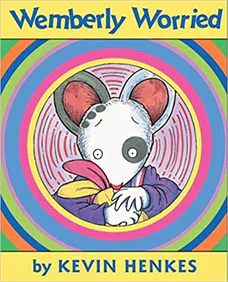Wemberly Worried
Written and illustrated by Kevin Henkes
32 pages
•
Published 2010 (Greenwillow Books)

Recommended Age Range: Preschool through 2nd grade
Publisher's Summary:
Wemberly worried about everything. Big things. Little things. And things in between. Then it was time for school to start. And Wemberly worried even more. If you ever worry (or know someone who does), this is the book for you.

Dr. Annie's Takeaways
Recommended for: A child with lots of worries will feel seen by this story and will likely feel reassured that despite their worries, they can still make friends and have fun. It’s ideal for children who have been criticized for worrying and/or who have started to criticize themselves for it and who need a reminder that this isn’t helpful or deserved. It’s also a great starter to a conversation between a child and their caregivers about what their caregivers can do to be helpful when the child is feeling worried (e.g., helping them to engage in something fun even if they’re worried!) instead of simply imploring the child not to worry.
Would a child like it? A child who worries will definitely relate to Wemberly and feel validated by this story. It has a sweet, relatively realistic ending.
Tone: Cheerful
Story Quality: Most of Wemberly Worried is an articulation of the many different worries that Wemberly has (and how unhelpful it is when adults tell a child not to worry). It resolves by Wemberly going to school and continuing to worry (“no more than usual and sometimes even less”) but despite this, she makes a friend and has fun on her first day of school. In comparison to many other books on this topic, Wemberly’s worries are fairly representative of the types of real worries children have–specific, a bit zany, sometimes dark– and I love that the book didn’t end with Wemberly abolishing her worries. She still worries, but she’s able to make a friend (who also worries) and have fun. This book is simply written, very accessible to a child, and has an authenticity. It doesn’t have an immense amount of resolution, but I actually rather like that about it.
Illustrations: Sweet, slightly old-fashioned-looking watercolor and colored pencil drawings.
Representation: Wemberly is a female mouse. She lives with her mother mouse, father mouse, and grandmother mouse, and she makes a friend at school who is also a female mouse. She lives in a house with a white picket fence, near a park with a playground, and she goes to school with a female mouse teacher.
Psychological Practices: This book normalizes having a lot of worries and helps children to put a label (worry) to their fears. It gently chastises adults for saying unhelpful things like, “You worry too much” and aligns with a worried child who has certainly experienced frustrating attempts by adults to convince them to stop worrying. The primary messages of the book are that worries happen, the child reading the book is not alone in being a worrier, and worries don’t mean that a child can’t still have fun and do things they care about. Acceptance and Commitment Therapy (ACT)
providers will find these messages resonant with their practice.
Concerns: Wemberly’s parents and grandmother spend the story criticizing Wemberly for worrying too much. My interpretation is that the story is trying to show how unhelpful this is, but to clarify, it’s not helpful to tell a worrying child that they’re worrying too much.
